Seat Exeo 2008 Owners Manual
Manufacturer: SEAT, Model Year: 2008, Model line: Exeo, Model: Seat Exeo 2008Pages: 303, PDF Size: 10.02 MB
Page 91 of 303

Cockpit89
Safety First
Operating instructions
Practical tips
Te c h n i c a l D a t a
Tyre pressure monitoring display
The tyre pressure should be corrected as soon as possible if
it is too low.If the
symbol appears, the tyre pre ssure on at least one of the
wheels is too low.
– Stop the vehicle.
– Check the tyre(s).
– Correct the tyre pressure ⇒page 228.
For more detailed information on the tyre pressure monitoring system, please
refer to ⇒page 227.
Exeo_EN.book Seite 89 Freitag, 17. Oktober 2008 11:24 11
Page 92 of 303

Steering wheel controls
90Steering wheel controlsThe multi-function steering wheelIntroduction
You can use the multi-function steering wheel to quickly and
easily operate selected functi ons of the radio, CD, TV* and
telephone*.
The functions are operated by pressing or scrolling the controls to on
the multi-function steering wheel ⇒ fig. 63:•
Press the button repeatedly to switch between modes, which
are then displayed in the driver information system ⇒fig. 64 .
•
Scroll and press the left thumbwheel to select a function from one of
the menus.
•
The speech control system* for the on-board phone system is enabled by
pressing the talk button . Pressing th e talk button again disables speed
control*.
•
Scroll the right thumbwheel up/down to raise/lower the volume as
desired.
Fig. 63 Controls on the
multi-function steering
wheel
Fig. 64 Driver informa-
tion system
AA
AD
MODE
AB
AA
AC
AD
Exeo_EN.book Seite 90 Freitag, 17. Oktober 2008 11:24 11
Page 93 of 303
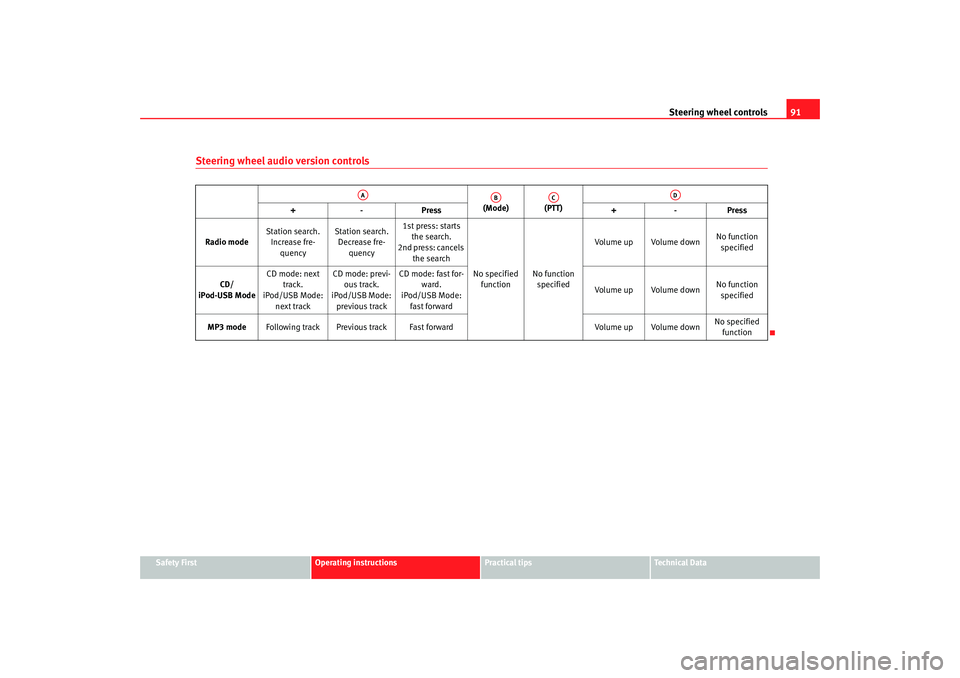
Steering wheel controls91
Safety First
Operating instructions
Practical tips
Te c h n i c a l D a t a
Steering wheel audio version controls
(Mode) (PTT)
+-P re ss +-Pre ss
Radio mode Station search.
Increase fre- quency Station search.
Decrease fre- quency 1st press: starts
the search.
2nd press: cancels
the search
No specified function No function
specified Volume up Volume down
No function
specified
CD/
iPod-USB Mode CD mode: next
track.
iPod/USB Mode:
next track CD mode: previ-
ous track.
iPod/USB Mode:
previous track CD mode: fast for-
ward.
iPod/USB Mode:
fast forward Volume up Volume down
No function
specified
MP3 mode Following track Previous track Fast forward Volume up Volume downNo specified
function
AA
AB
AC
AD
Exeo_EN.book Seite 91 Freitag, 17. Oktober 2008 11:24 11
Page 94 of 303
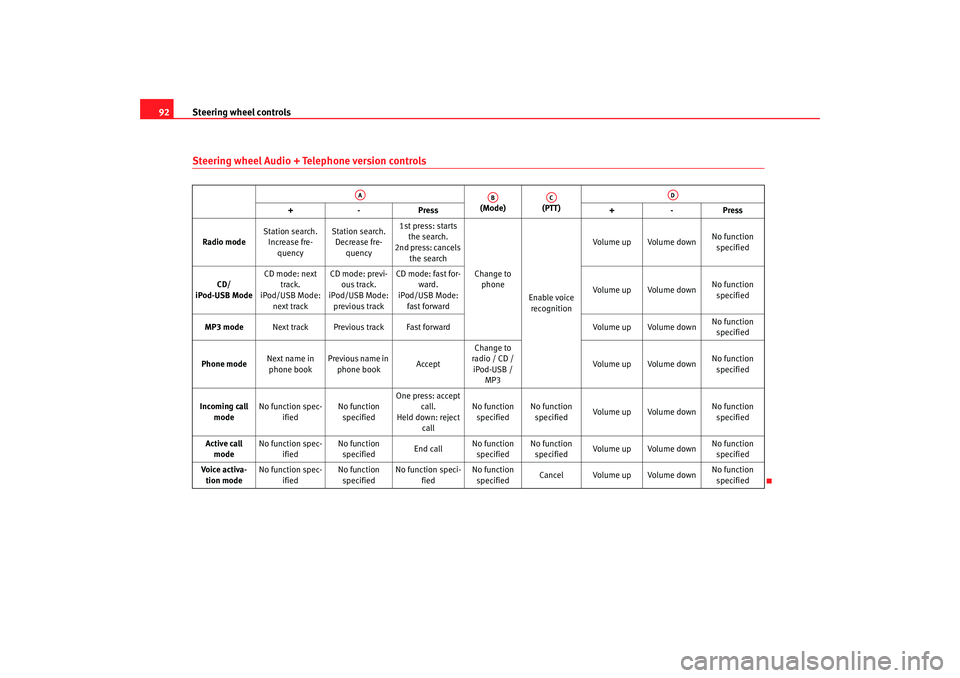
Steering wheel controls
92Steering wheel Audio + Telephone version controls
(Mode) (PTT)
+-P re ss +-Pre ss
Radio mode Station search.
Increase fre- quency Station search.
Decrease fre- quency 1st press: starts
the search.
2nd press: cancels
the search
Change to phone
Enable voice recognition Volume up Volume down
No function
specified
CD/
iPod-USB Mode CD mode: next
track.
iPod/USB Mode:
next track CD mode: previ-
ous track.
iPod/USB Mode:
previous track CD mode: fast for-
ward.
iPod/USB Mode:
fast forward Volume up Volume down
No function
specified
MP3 mode Next track Previous track Fast forward Volume up Volume downNo function
specified
Phone mode Next name in
phone book Previous name in
phone book AcceptChange to
radio / CD /
iPod-USB / MP3 Volume up Volume down
No function
specified
Incoming call mode No function spec-
ified No function
specified One press: accept
call.
Held down: reject call No function
specified No function
specified Volume up Volume down
No function
specified
Active call mode No function spec-
ified No function
specified End callNo function
specified No function
specified Volume up Volume down No function
specified
Voice activa- tion mode No function spec-
ified No function
specified No function speci-
fied No function
specified Cancel Volume up Volume down
No function
specified
AA
AB
AC
AD
Exeo_EN.book Seite 92 Freitag, 17. Oktober 2008 11:24 11
Page 95 of 303

Unlocking and locking93
Safety First
Operating instructions
Practical tips
Te c h n i c a l D a t a
Unlocking and lockingRemote control keysSet of keys
The set of keys belonging to your vehicle consists of the following items:
one remote control key.
one key without remote control.
one plastic key tab containing the key number.
Remote control key
The remote control key will lock and un lock the car and start the engine. Press
the release button ⇒fig. 66 -arrow- to make the key spring out of the handle
and to fold it back in.
Spare key
The spare key is not designed for continuous use. It should only be used in
the event of an emergency. Keep it in a safe place and do not carry it on the
key tab.
Fig. 65 Set of keys
supplied with the vehicle
Fig. 66 Remote control
key: Release button
AAABAC
Exeo_EN.book Seite 93 Freitag, 17. Oktober 2008 11:24 11
Page 96 of 303

Unlocking and locking
94Plastic key tab
Spare keys cannot be issued without the key number on the plastic key tab.
Therefore:•
Always keep the key tab in a safe place.
•
Never leave the key tab in the vehicle.
•
If you sell the vehicle, please give the plastic key tab to the new owner.
Replacing a key
If you lose a key, please contact the Technical Service. Have the remote
control coding for that key disabled. You should therefore bring the plastic
key tab and all available keys with you. It is also important to notify your
insurance company if a key or the plastic key tab has been lost.
WARNING
•
Always take the key with you when leaving the vehicle, even if you only
intend to be gone for a short time. This is particularly important if there are
children in the car, as they might otherwise be able to start the engine or
use power-operated equipment (e.g. the electric windows), which could
lead to injuries.
•
Wait for the vehicle to come to a standstill before removing the ignition
key from the lock! Otherwise, the steering lock could engage suddenly,
causing an accident.
Indicator light on the remote control key
The condition of the battery in the remote control key is moni-
tored by the indicator light.Condition of the key battery
The indicator light ⇒fig. 67 (arrow) flashes when one of the buttons is
pressed. If the indicator light does not light up or flash, this means that the
battery is exhausted and must be replaced.
Replacing the batteries ⇒ page 95.
Fig. 67 LED on the remote
control key
Exeo_EN.book Seite 94 Freitag, 17. Oktober 2008 11:24 11
Page 97 of 303

Unlocking and locking95
Safety First
Operating instructions
Practical tips
Te c h n i c a l D a t a
Replacing the key batteryWe recommend you have the batteries changed in a specialist
garage. If you decide to change the used battery yourself, follow the
steps below:
–Carefully prise apart the key ⇒fig. 68 and the cover
using a coin.
– Remove cover in the direction of the arrow.
– Remove the used battery from the cover.
– Insert the new battery. Make sure that the “+” symbol on the battery is facing downwards. The correct polarity is indicated on
the cover.
– After inserting the battery, align the cover and key and press the two parts together. For the sake of the environment
Used batteries must be disposed of appropriately and must not be discarded
with ordinary household waste.
Note
•
The system must be re-synchronised after each battery replacement to be
able to lock and unlock the car using the remote control ⇒page 103.
•
The new battery must be of the same type as the original.
Electronic immobiliser
The electronic immobiliser is designed to prevent unauthor-
ised persons from starting up the vehicle.There is an electronic chip inside th e key which automatically deactivates the
immobiliser when the key is inserted into the ignition lock. The electronic
immobiliser is enabled automatically when the ignition key is removed from
the ignition lock after coming to a stop.
If an uncoded key is used, the message SAFE will appear in the trip recorder
display.
Note
•
The engine can only be started using an original SEAT key with the correct
code.
•
It may not be possible to start the engine with the key if there is another
ignition key from a different make of vehicle on the same key tab.
Fig. 68 Master key:
Opening the cover
AA
AB
Exeo_EN.book Seite 95 Freitag, 17. Oktober 2008 11:24 11
Page 98 of 303
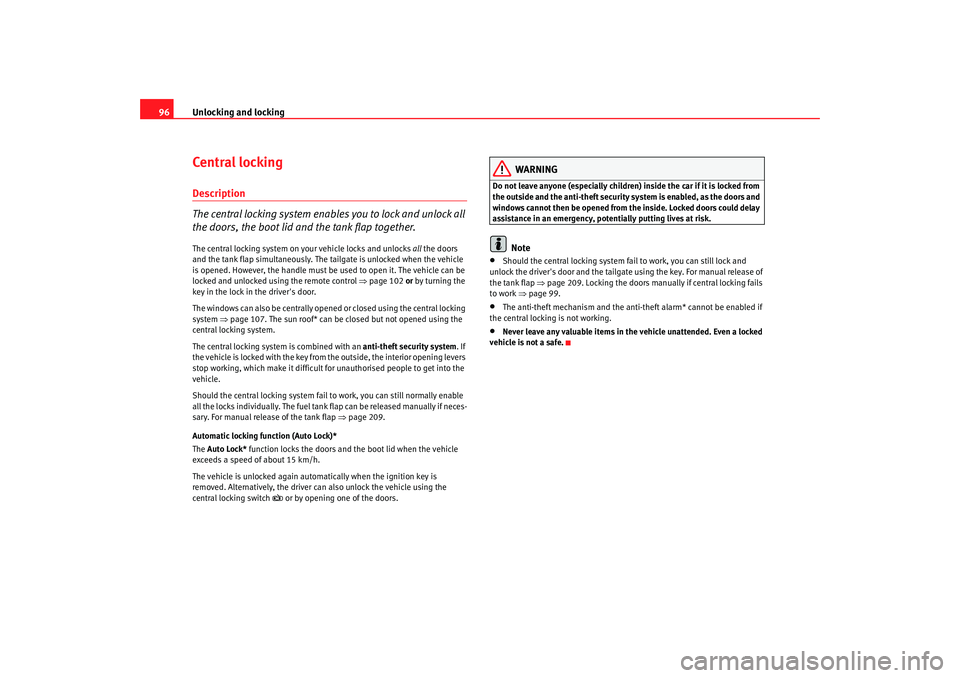
Unlocking and locking
96Central lockingDescription
The central locking system enables you to lock and unlock all
the doors, the boot lid and the tank flap together.The central locking system on your vehicle locks and unlocks all the doors
and the tank flap simultaneously. The tailgate is unlocked when the vehicle
is opened. However, the handle must be used to open it. The vehicle can be
locked and unlocked using the remote control ⇒page 102 or by turning the
key in the lock in the driver's door.
The windows can also be centrally opened or closed using the central locking
system ⇒page 107. The sun roof* can be closed but not opened using the
central locking system.
The central locking system is combined with an anti-theft security system. If
the vehicle is locked with the key from the outside, the interior opening levers
stop working, which make it difficult fo r unauthorised people to get into the
vehicle.
Should the central locking system fail to work, you can still normally enable
all the locks individually. The fuel tank flap can be released manually if neces-
sary. For manual release of the tank flap ⇒page 209.
Automatic locking function (Auto Lock)*
The Auto Lock* function locks the doors and the boot lid when the vehicle
exceeds a speed of about 15 km/h.
The vehicle is unlocked again automatically when the ignition key is
removed. Alternatively, the driver can also unlock the vehicle using the
central locking switch
or by opening one of the doors.
WARNING
Do not leave anyone (especially children) inside the car if it is locked from
the outside and the anti-theft security system is enabled, as the doors and
windows cannot then be opened from the inside. Locked doors could delay
assistance in an emergency, potentially putting lives at risk.
Note
•
Should the central locking system fail to work, you can still lock and
unlock the driver's door and the tailgate using the key. For manual release of
the tank flap ⇒page 209. Locking the doors manually if central locking fails
to work ⇒page 99.
•
The anti-theft mechanism and the anti-theft alarm* cannot be enabled if
the central locking is not working.
•
Never leave any valuable items in the vehicle unattended. Even a locked
vehicle is not a safe.
Exeo_EN.book Seite 96 Freitag, 17. Oktober 2008 11:24 11
Page 99 of 303
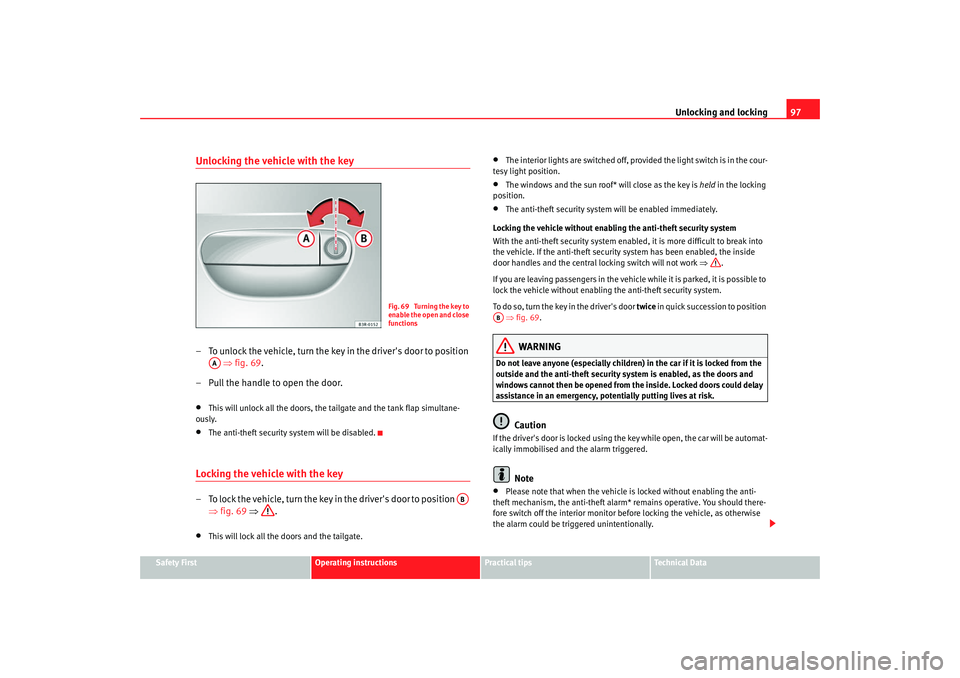
Unlocking and locking97
Safety First
Operating instructions
Practical tips
Te c h n i c a l D a t a
Unlocking the vehicle with the key– To unlock the vehicle, turn the key in the driver's door to position
⇒ fig. 69 .
– Pull the handle to open the door.•
This will unlock all the doors, the tailgate and the tank flap simultane-
ously.
•
The anti-theft security system will be disabled.
Locking the vehicle with the key– To lock the vehicle, turn the key in the driver's door to position
⇒ fig. 69 ⇒ .•
This will lock all the doors and the tailgate.
•
The interior lights are switched off, provided the light switch is in the cour-
tesy light position.
•
The windows and the sun roof* will close as the key is held in the locking
position.
•
The anti-theft security system will be enabled immediately.
Locking the vehicle without enabling the anti-theft security system
With the anti-theft security system enabled, it is more difficult to break into
the vehicle. If the anti-theft security system has been enabled, the inside
door handles and the central locking switch will not work ⇒.
If you are leaving passengers in the vehicle while it is parked, it is possible to
lock the vehicle without enabling the anti-theft security system.
To do so, turn the key in the driver's door twice in quick succession to position
⇒ fig. 69 .
WARNING
Do not leave anyone (especially children) in the car if it is locked from the
outside and the anti-theft security system is enabled, as the doors and
windows cannot then be opened from the inside. Locked doors could delay
assistance in an emergency, potentially putting lives at risk.
Caution
If the driver's door is locked using the key while open, the car will be automat-
ically immobilised and the alarm triggered.
Note
•
Please note that when the vehicle is locked without enabling the anti-
theft mechanism, the anti-theft alarm* remains operative. You should there-
fore switch off the interior monitor be fore locking the vehicle, as otherwise
the alarm could be triggered unintentionally.
Fig. 69 Turning the key to
enable the open and close
functions
AA
AB
AB
Exeo_EN.book Seite 97 Freitag, 17. Oktober 2008 11:24 11
Page 100 of 303
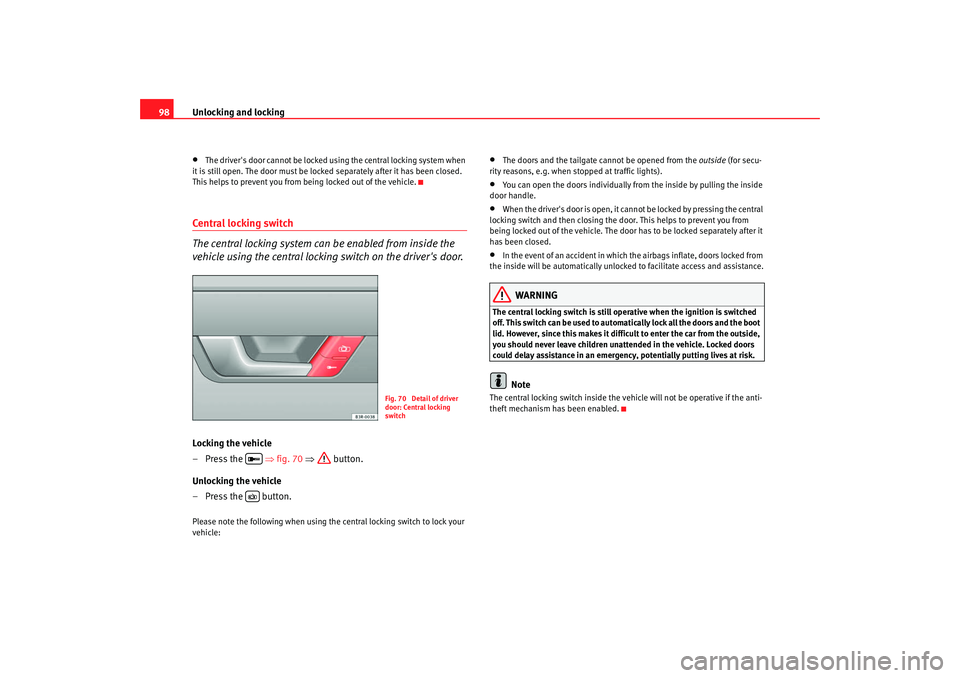
Unlocking and locking
98•
The driver's door cannot be locked using the central locking system when
it is still open. The door must be lo cked separately after it has been closed.
This helps to prevent you from being locked out of the vehicle.
Central locking switch
The central locking system can be enabled from inside the
vehicle using the central locking switch on the driver's door.Locking the vehicle
– Press the ⇒fig. 70 ⇒ button.
Unlocking the vehicle
– Press the button.Please note the following when using the central lock ing switch to lock your
vehicle:
•
The doors and the tailgate ca nnot be opened from the outside (for secu-
rity reasons, e.g. when stopped at traffic lights).
•
You can open the doors individually from the inside by pulling the inside
door handle.
•
When the driver's door is open, it cannot be locked by pressing the central
locking switch and then closing the door. This helps to prevent you from
being locked out of the vehicle. The door has to be locked separately after it
has been closed.
•
In the event of an accident in which the airbags inflate, doors locked from
the inside will be automatically unlocked to facilitate access and assistance.
WARNING
The central locking switch is still op erative when the ignition is switched
off. This switch can be used to autom atically lock all the doors and the boot
lid. However, since this makes it difficu lt to enter the car from the outside,
you should never leave children unattended in the vehicle. Locked doors
could delay assistance in an emergency, potentially putting lives at risk.
Note
The central locking switch inside the vehicle will not be operative if the anti-
theft mechanism has been enabled.
Fig. 70 Detail of driver
door: Central locking
switch
Exeo_EN.book Seite 98 Freitag, 17. Oktober 2008 11:24 11